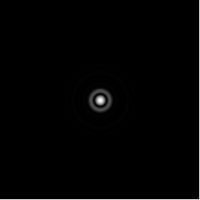Glossary | Telescopes | Reflector | Secondary mirror obstruction
 Obstruction = 0%
Obstruction = 0%A telescope is a light trap, which bundles all the collected light together and produces an image. With Newtonian telescopes, however, a secondary mirror deflects the light to the side into the focuser, because otherwise you would not be able to observe with it. Other designs are also obstructed by a secondary mirror.
What the secondary mirror does with the light ...
 Obstruktion = 40%
Obstruktion = 40%The secondary mirror in optical systems creates a shadow, which reduces the contrast and effective aperture performance. Every component in the optical path of a telescope creates this shadow, known as obstruction. This is basically the case for all reflector telescopes (the exception is the 'Schiefspiegler' = oblique reflector). Only a refractor has 0% obstruction, since no components disturb the optical path.
In the illustrations, you can see that the image is diffracted by an obstruction, resulting in a loss of contrast. The larger the secondary mirror, the greater the obstruction.
To find the contrast performance, or the contrast loss, of a telescope, you simply deduct the diameter of the secondary mirror from the diameter of the primary mirror. This gives you the effective contrast aperture that a telescope without obstruction would have.
